Easy Homemade French Bread
Homemade French bread has never been easier! This simple recipe produces a light and fluffy loaf of French bread that will rival any bakery!
This easy homemade French bread is so simple and perfect for a bread making beginner.
But as you can see from all the comments below, it’s just as valued by expert bread makers, too!
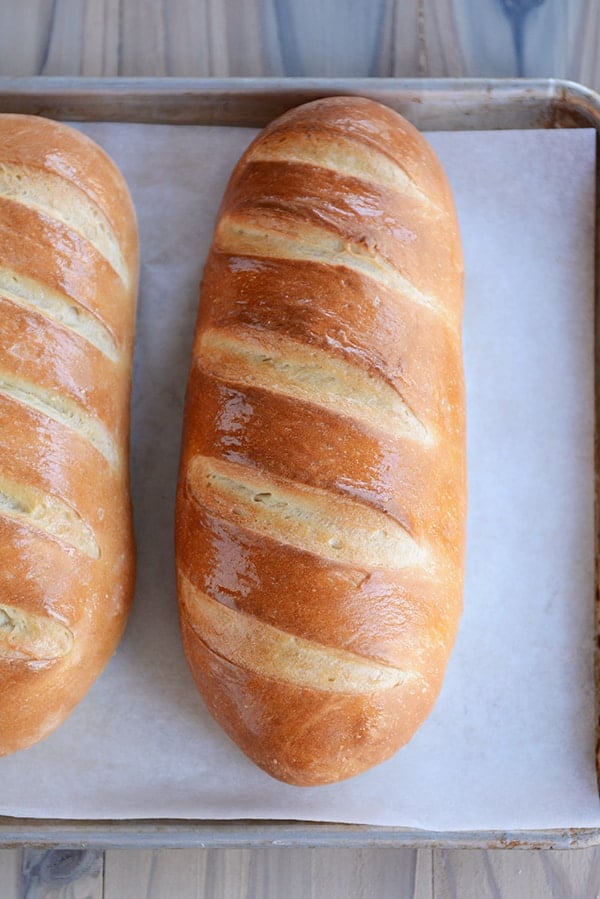
Making French Bread Dough
This straightforward bread dough can be made in a stand mixer or by hand.
- Warm water
- Yeast (instant or active dry yeast)
- Bit of sugar and oil
- Salt
- Flour (all-purpose or bread flour)
At the start, the dough will look shaggy and rough.
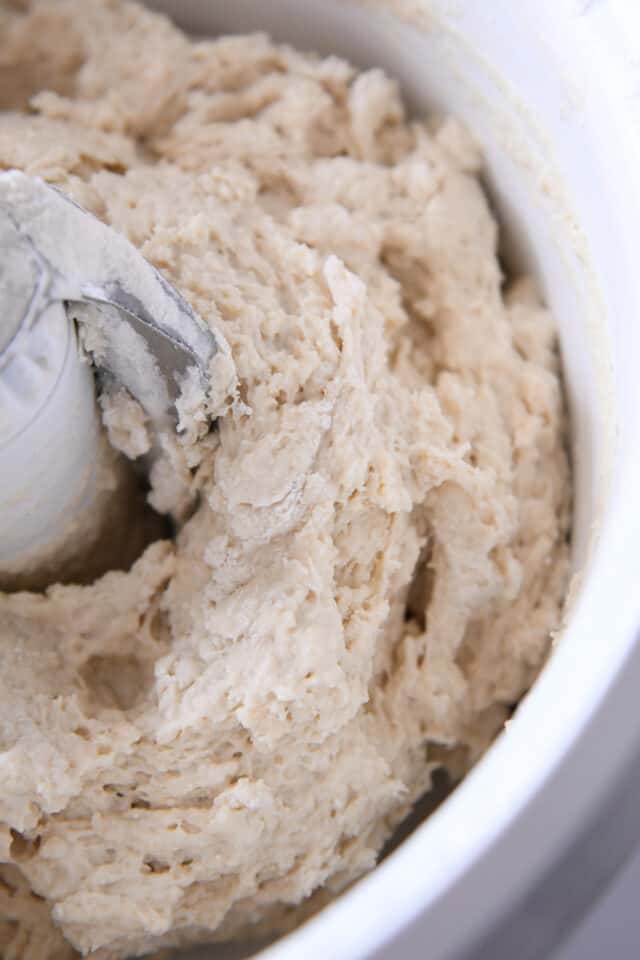
But as it kneads, it will become soft and smooth.
The most important part of this dough (and other yeast doughs) is to judge the amount of flour by the look and feel of the dough rather than the exact amount of flour called for in the recipe.
Factors such as humidity, elevation, room temperature, how we each measure flour, and more can affect the amount of flour added. So don’t stress about precise flour measurements and continuously feel the dough to achieve a soft dough that is slightly tacky but doesn’t leave a lot of residue on your fingers.
Too little flour and the dough will be a mess to handle. Additionally, the bread won’t hold its shape as it rises and bakes.
Too much flour and the dough won’t rise well and the bread will be tough and dense.
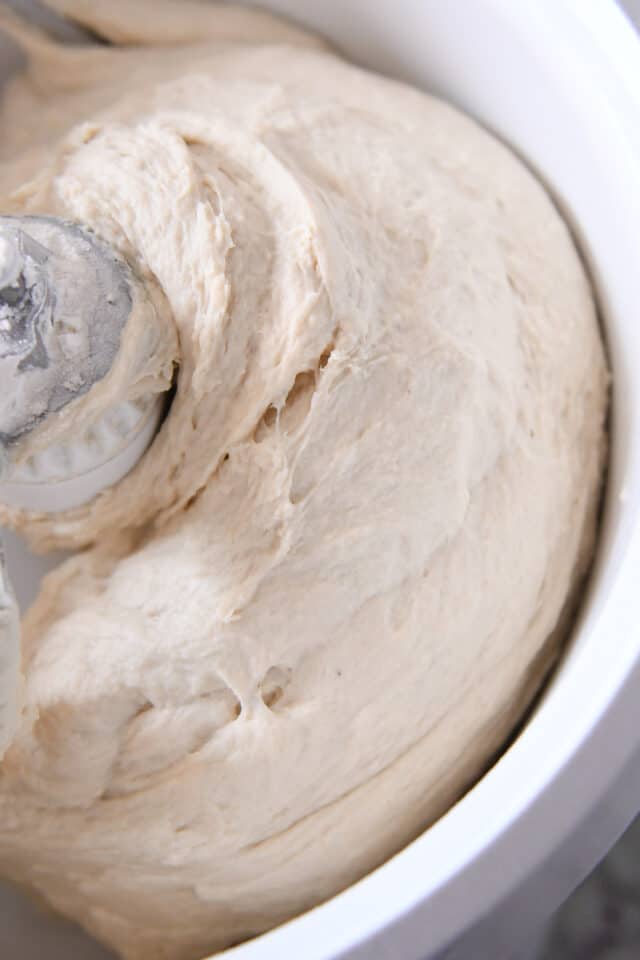
Two Methods for Dough Rising
In the recipe, there are two methods to letting the dough rise:
- Leave the dough in the mixer, cover with a lid or towel, and let the dough rest for 10 minutes. Stir it down by turning on the mixer for 10 seconds or so. Repeat the “rest and stir down” cycle five more times.
- Transfer the dough to a lightly greased bowl and cover with a towel or greased plastic wrap. Let the dough rise until doubled, about an hour or so, depending on the warmth of your kitchen.
I alternate between the two methods depending on my mood. The 10-minute increment rising method is unique to this original French bread recipe. The idea is that allowing the dough to rise this way produces a lighter crumb.
But the more traditional rising method also results in a delicious, fluffy loaf.
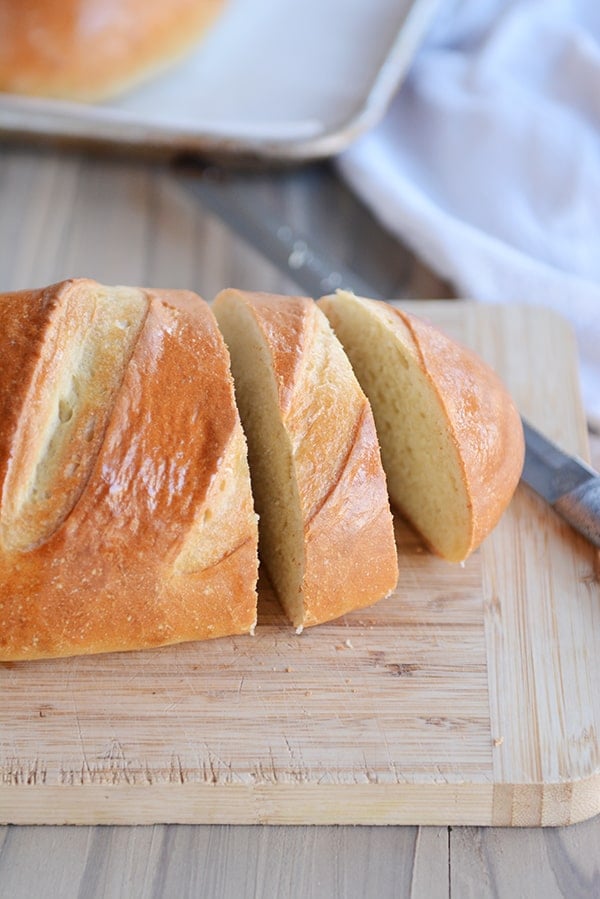
How to Shape French Bread Loaves
The question I get asked the most about this easy homemade French bread is how to shape the loaves.
The loaves can really be made any size or shape; I usually end up making 12-inch loaves, but if they end up being a bit thinner or chubbier, it’s no big deal!
Press each portion of dough into a flat rectangle and fold the bottom edge up and over the dough, pressing the seam flat with your hand.
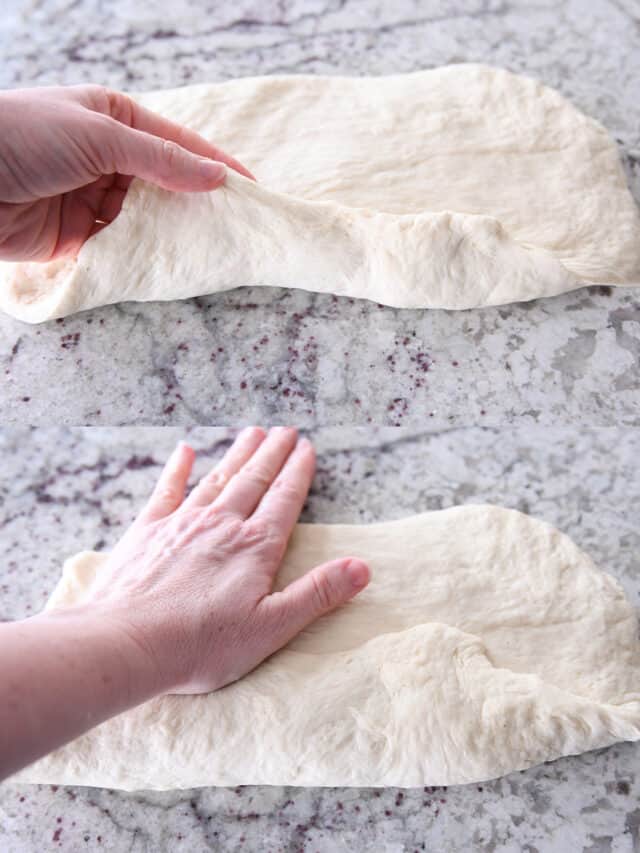
Then, roll the dough up again to meet the top edge.
Fold the top edge over and press or pinch lightly.
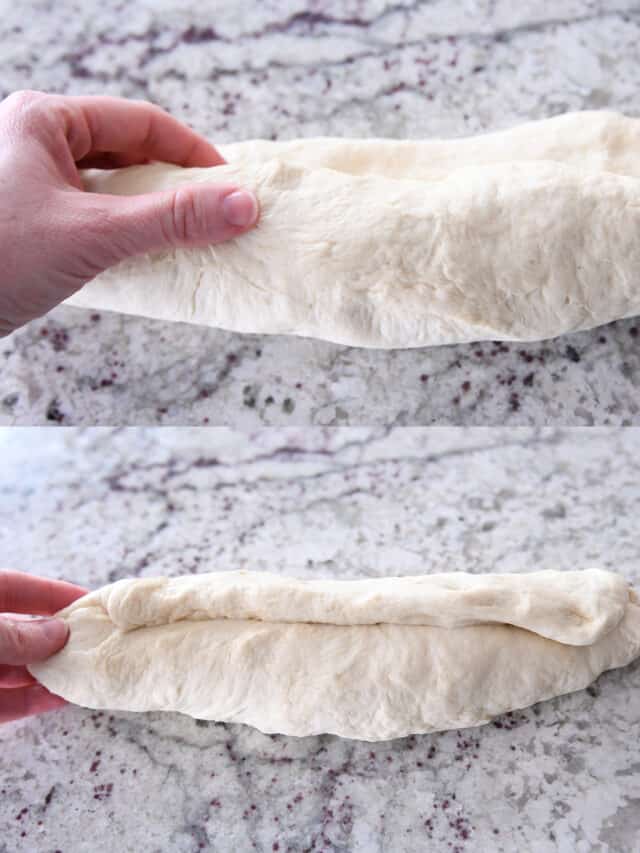
Take the end of the bread dough and fold it up and over an inch or two to give an even thickness all the way down the loaf.
Pinch to seal the end. Repeat on the other end of the dough.
Then, deliberately and thoroughly pinch and seal the entire length of the loaf.
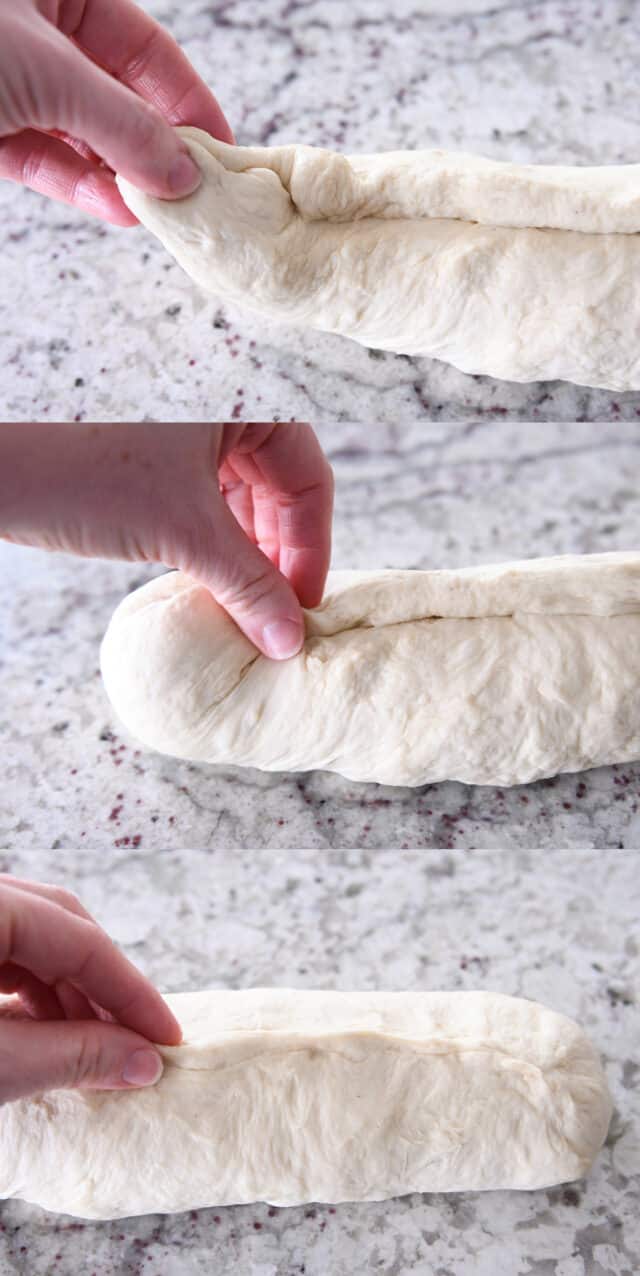
How to Score the French Bread Dough
Scoring the bread dough (in my house, also called: slashing or gashing) helps the dough rise better AND prevents it from cracking in unexpected places while baking.
Using a bread lame for this task is extremely helpful. A bread lame is a long stick or utensil with a razor blade on the end. The razor is used to make thin cuts in the dough.
If you don’t have a bread lame, using a clean, sharp razor blade or an extremely sharp kitchen knife can work. Be aware that if the knife isn’t sharp enough, it’ll likely deflate the dough.
The bread loaves can be scored before or after the final rise. I prefer to do the slashing and gashing before they rise as I’ve had one too many loaves of risen bread deflate at the first touch of the razor, and there is nothing so soul crushing as when that happens.
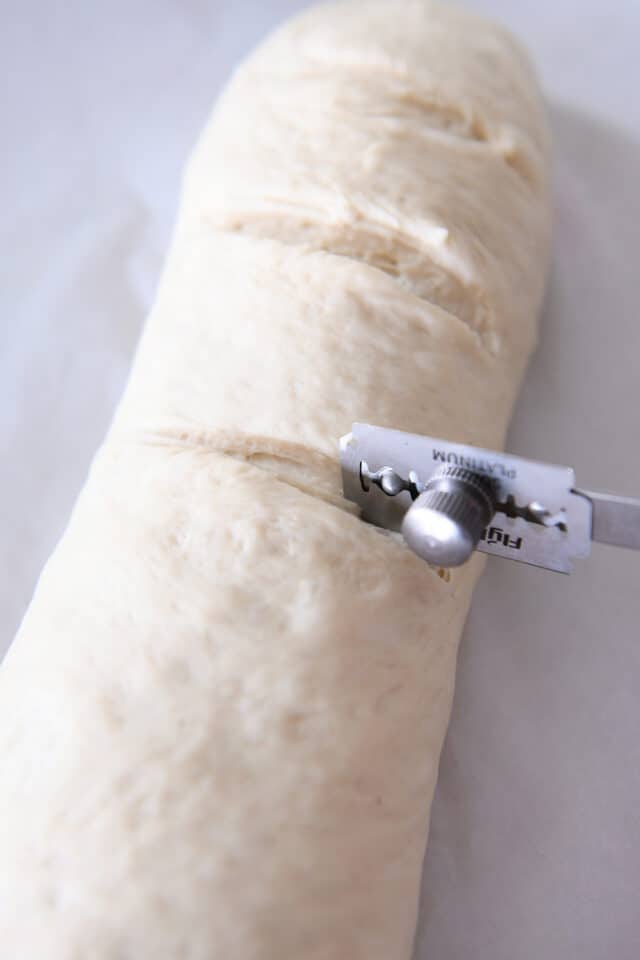
Let the bread loaves rise until noticeably puffy before baking.
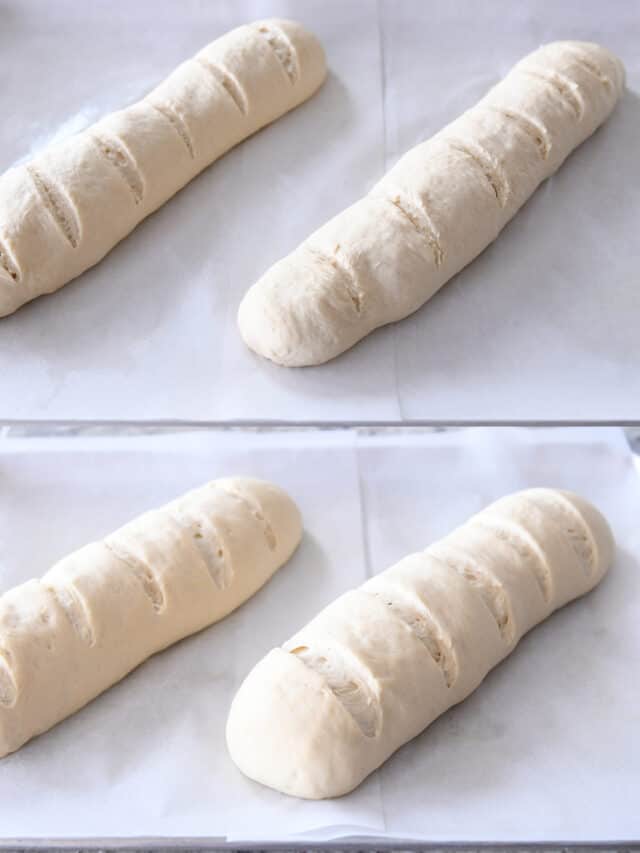
Easy Hack for Crusty French Bread
For a delicious golden crust, immediately before putting the bread in the oven, toss 3-4 ice cubes onto the bottom of the oven. Add the bread and quickly (but gently!) close the oven door.
The steam as the ice cubes hit the toasty bottom of the oven will lightly crisp up the outer crust as the bread bakes.
Important Note! Please consult your oven’s manual for details or caution on putting ice/water on the bottom of the oven floor – I’ve never had a problem, but everyone should do their own research and use their own best judgment (also take care not to toss the ice cubes on the glass oven door as it could crack).
If you are struggling to get a deeper golden crust on the French bread, try:
- Increasing the oven temperature by 25 degrees and/or
- Moving the oven rack up one position (I find my bread browns the best in the middle or upper middle area of my oven)
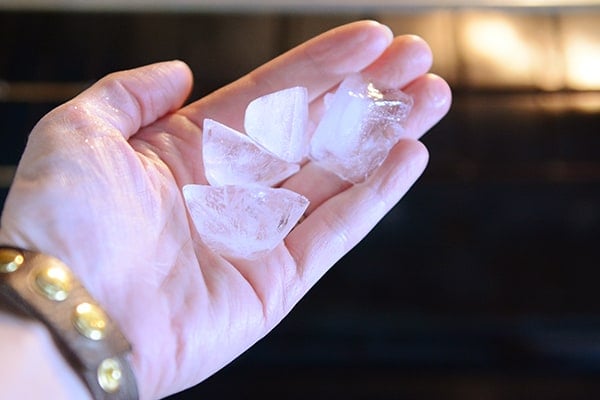
Whole Wheat French Bread
As noted in the recipe, French bread works quite well using whole wheat flour. I’ve found the best results are when using white whole wheat flour (red whole wheat flour makes a denser, heavier loaf).
I recommend subbing in half whole wheat flour to start and then adding more whole wheat flour as you continue to make subsequent batches of bread.
If using whole wheat flour, add a 2-3 minutes to the kneading time to help develop the gluten (also, adding a couple tablespoons of vital wheat gluten/gluten flour can also help the whole wheat bread bake up light and fluffy).
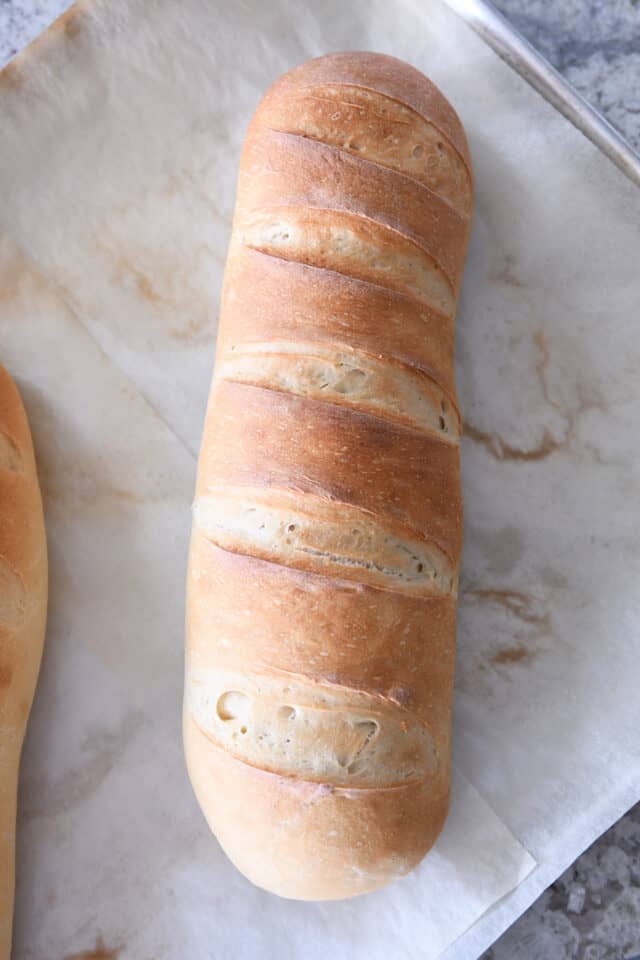
Helpful Tip: If you’ve struggled with your bread flattening out while baking instead of holding the perfect shape, you might try these French bread pans {aff. link}. I have them and LOVE them. I don’t use them every time I make this bread, but I do pull them out quite often (I also use them for this rosemary bread).
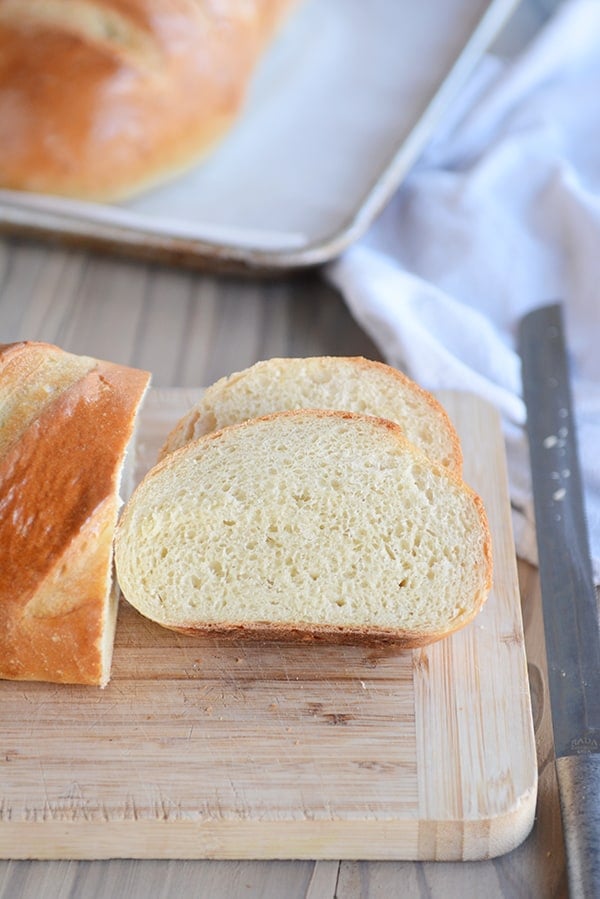
Perfect Homemade French Bread
With over 2,500 5-star reviews, this homemade French bread has become a favorite for so many of you.
Hundreds of you have let me know that you have been intimidated by homemade bread until you found this recipe! It is easy, foolproof, and will make you feel like a bread making rock star.
Helena says: Finally, after 5 failed bread attempts using other places recipes, this is THE recipe to use! Happy dance! Thank you for sharing this awesome recipe! Delicious bread!
Valerie writes: Such a fantastic, easy recipe. The “hands on” time is minimal and it comes out perfect every time. Thanks for sharing a recipe that’s become my “to do” dinner bread!
Nichole says: Followed instructions exactly! First time making any sort of bread ever. The bread turned out perfect!!!!
Pia commented: Hands down my go-to bread recipe. Today’s edition is 1/3 dark rye flour, with Italian herbs and caraway seeds mixed in and sprinkled with everything bagel topping. Yum! Best bread recipe ever, and so easily customizable!
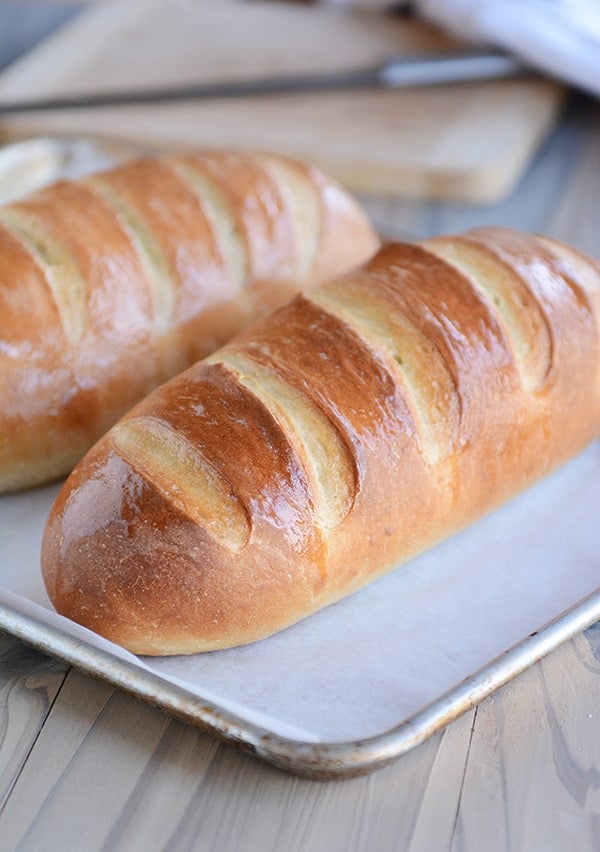
FAQs for Homemade French Bread
Yes! Halve all the ingredients straight across – just keep an eye on the amount of flour and judge the final amount by the look and feel of the dough.
Yes, it freezes great (after baking and cooling).
Moving an oven rack up or down can help. In my oven, the bread browns best in the upper half of the oven. Also, you can try increasing the oven temp by 25 degrees.
Absolutely! You can mix the ingredients in a bowl with a spatula or spoon and knead by hand.
I always use the same amount interchangeably. Recently, I’ve heard that active dry yeast doesn’t need to be proofed in liquid first, but I always still do when using active dry yeast (no need to proof with instant yeast).
Yes, just keep an eye on baking time – smaller loaves may need less baking time.
One Year Ago: Harvest Pasta Sauce {Trader Joe’s Copycat}
Two Years Ago: Peanut Butter Cup Cheesecake with Chocolate Cookie Crust
Three Years Ago: Easy Homemade Egg Noodles {Step-by-Step Pictures Include Food Processor Method or By Hand}
Four Years Ago: Black Bean and Butternut Enchilada Skillet
Five Years Ago: Chocolate Chip Peanut Butter and Oatmeal Cookies
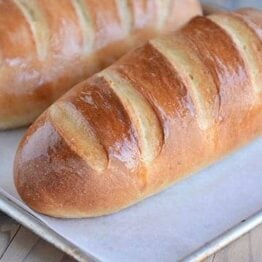
Easy Homemade French Bread
Ingredients
- 2 ¼ cups warm water, 110-115 degrees F
- 2 tablespoons granulated sugar
- 1 tablespoon instant or active dry yeast
- 2 ¼ teaspoons salt (see note)
- 2 tablespoons olive oil, canola oil, vegetable oil or avocado oil
- 5 ½ – 6 cups (781 – 852 g) all-purpose flour or bread flour (see note)
Instructions
- In the bowl of an electric stand mixer fitted with the dough hook, combine the water sugar and yeast. If using active dry yeast, let the mixture bubble and foam before proceeding (this can take 3-5 minutes). If using instant yeast, proceed with the recipe (no need to let the yeast activate).
- Add the salt, oil and 3 cups of flour and mix. Add in 2 1/2 to 3 more cups of flour gradually. The dough should clear the sides of the bowl and form a soft ball that doesn't leave a lot of dough residue on your fingers.
- Knead for 2-3 minutes until the dough is smooth. If the dough starts to cling to the sides of the bowl (or the center column if using a Bosch or other mixer with a center), add 1/4 cup of flour at a time until a sturdy but soft ball of dough forms.
- Rising Method 1: Leave the dough in the mixer, cover with a lid or towel, and let the dough rest for 10 minutes. Stir it down by turning on the mixer for 10 seconds or so. Repeat the "rest and stir down" cycle five more times.
- Rising Method 2: Instead of letting the dough rest for 10 minute spurts and then stirring it down, transfer the dough to a lightly greased bowl and cover with a towel or greased plastic wrap. Let the dough rise until doubled, about an hour or so, depending on the warmth of your kitchen.
- Turn the dough onto a lightly greased surface and divide in half. Pat each section into a thick rectangle, 9X13-inches or thereabouts (doesn't have to be exact). Roll the dough up starting from the long edge, pressing out any air bubbles or seams with the heel of your hand, and pinch the edge to seal. Arrange seam side down on a large baking sheet lined with parchment paper (I use separate baking sheets for each loaf).
- With a bread lame, razor blade or VERY sharp knife, cut several gashes at an angle on the top each loaf (you can wait to score the bread until after it rises, but it can easily deflate if the razor/knife isn't sharp enough).
- Cover the loaves with greased plastic wrap or a kitchen towel, and let rise until noticeably puffy and nearly doubled in size, about an hour.
- Preheat the oven to 375 degrees F and make sure an oven rack is in the center position. If you find your bread isn't browning as much as you like, preheat the oven to 400 or 425 degrees and/or move the oven rack up one position (watch carefully so the bread, especially the bottom, doesn't burn).
- Optional: for an extra golden, crisp crust, place the loaves in the preheated oven and immediately toss 3-4 ice cubes on the bottom of the oven. Close the oven door quickly but gently. (See note below!)
- Bake the loaves for 25-30 minutes until golden and baked through.
- If desired, brush melted butter over the hot loaves (this softens the crust a bit, so if you want a crispier crust, don't butter the top).
Notes
Recipe Source: adapted slightly from The Sister’s Cafe
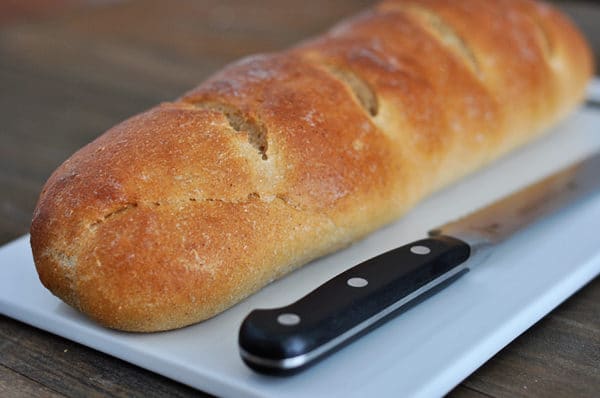

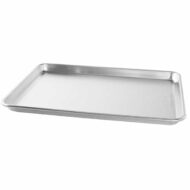
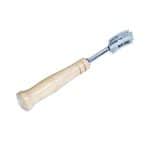
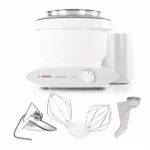
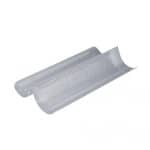
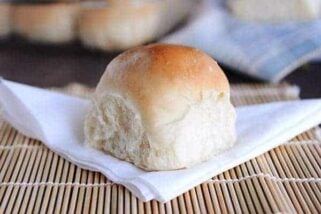
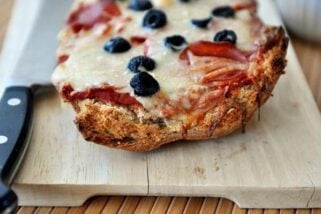
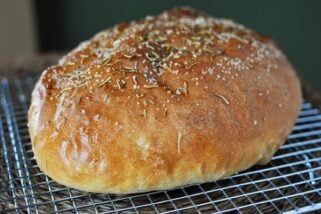
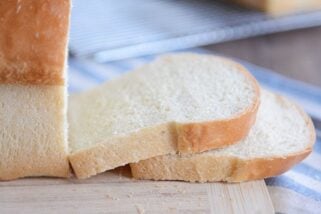
Thank you for sharing your recipe. I’d lost my similar French Bread recipe and was happy to find yours! Love the helpful hint about slashing after shaping as I’ve always “struggled” with deflating loaves when slashed right before going in the oven. My oven won’t handle steam, so I sprayed the loaf with water. Beautiful loaf, exactly what I was wanted to make!
Absolutely incredible recipe. Will be a staple in my home for many years. Pure perfection. Fluffy, crispy and awesome.
I love this bread recipe but my loaves are forever turning out flat. I reread your post and it sounds like I should add more flour? The dough is always sticky but I don’t want to add too much flour. Please help. I make this weekly and we use it as sandwich bread and I would love to have slightly taller, narrower slices than the short, wide slices I’ve been getting.
WOW This was a game changer for me!! I’ve been struggling for a year trying to make French Bread. All but gave up.
What you said about doing the slashes BEFORE the last rise was the best advice ever!!!
Mine was always deflating when i would score (slash) them right before baking them.
And I always thought that I was over kneading it, was the reason it would deflate.
And adding just enough flour a little at a time til it comes to the right consistency was also very very helpful too. I had 1/2 cup of flour left over. Thank you for the wonderful recipe and the great advice! I sure needed to hear it :)))))) I made a big crock pot of beef stew and we hade this delicious French bread with it with butter. It was divine! My family went on and on about how good the meal was and they loved the bread.
Thanks again !!
Hi, Mel. I used all the ingredients in recipe plus a heaping Tbs. of Barley Malt Syrup. I am lazy I admit! I added all ingredients except oil, water and BMS. Mixed well. Added BMS to water, mixed and added to dry ingredients. Kneaded in KitchenAid mixer with dough hook for about 3 minutes then added oil and continued kneading for about 5 more minutes. Let rise for 1 hour in oiled bowel covered with plastic wrap.
Made my loaves and let rise again, covered with Pam sprayed plastic wrap for an hour.
Heated oven to 425 degrees. Dropped a handful of ice on bottom of oven and put loaves on slightly above center oven rack. Turned heat to 375 degrees and baked for about 35 minutes.
P.S. I used a full Tbs. of kosher salt..
Best French bread I’ve ever made.
Thanks bunches!
Helpful review. Thanks, Jim!! Glad this worked out so well for you.
Thanks for the fantastic recipe! I made 2 loaves this morning and they came out beautiful! I decided to double the recipe and made 2 more loaves, plus a pan of rolls. All turned out very good. The consistency of the bread is wonderfully fluffy and the flavor is delicious. Easily executed and less time consuming than most recipes I have used. Bravo!
I almost always make bread on Sunday, and since this makes two loaves, we can have one then, then devour the other loaf along the coarse of the next few days, it is also just the best plain feasted bread recipe I have! Thank you Mel.
I add some cornmeal sprinkled on top before baking to give it that sort of gritty finish and my kids LOVE it! Now I make this recipe doubled at least once a month
So easy and absolutely delicious! I made this to have with dinner tonight. Glad it makes 2 loaves because we devoured one immediately!
Instead of tossing ice in the oven, why not put them in a pan on the lowest rack? This is the usual technique, never heard of anyone actually tossing them in the oven.
This was seriously the best bread I’ve ever made..which in turn created the most delicious meatball sub I’ve ever had. Thank you for this wonderful recipe! My go to from now on.
I am a fairly experienced bread maker but had a little trouble with this one. It was too dense and didn’t rise like it should have (good yeast, warm kitchen). I am determined to try again but the first pass tasted good but wasn’t quite what I had hoped for.
Absolutely delicious!! Followed recipe in my stand mixer and total hit with the fam.. Thank you!!!
Why does my bread have a hole in the middle?
It’s likely due to how the loaf was shaped or rolled – make sure to press out any air bubbles as you are forming the loaf.
Loved this recipe…now I don’t have a stand mixer so I do all by hand ( which i find VERY relaxing ) but the family loved it. 1st time I made it with the less salt…family said it needed salt. 2nd time I added the 1tbsp salt they loved it. Quick question tho bc 2nd time I made mini loaves… how can I store these ?
At the point where you half the dough and form two loaves, can I take one and store in fridge for a night then back the next day?
Yes
Let the bread cool and then store in bread bags (completely closed) at room temperature. The loaves can also be frozen. But don’t store the bread in the refrigerator – it dries out quicker.
I love this bread so much, I make it weekly!! Would love to prep some ahead of time and freeze it but have never done that before. When you thaw do you do that on the counter or in the fridge? Does it need to be refrigerated once it thaws out?
Are you planning to bake the bread and then freeze it or freeze the dough?
This is my favorite bread recipe! My family begs me to make this for a special treat! 🩷🩷🩷
Could have built a house with my loaves. Solid heavy dense. Something was not right about recipe, might be yeast. But everything said fresh. Followed recipe exact. Never again.
If you put a metal bowl in the oven then preheat you can pour water in it instead of just tossing ice in!
This is not a French bread recipe- it’s a white bread shaped like a French loaf. French bread is just flour, salt, yeast and water!
I’m sure your white bread is delicious though.
Amazing bread recipe, I got excited and forgot to half the recipe, i took small dough balls and flattened them and pan fried them with some veggie oil. Man they are amazing. (Ps. Running them through a pasta roller works wonders).
Thanks for sharing this great recipe! I’ll never be buying garlic bread again. Currently have a batch in it’s first rise now 🙂
We used rise method 1, baked it for 27 minutes, and it turned out incredible Soft, light, and fluffy; we are definitely making this again instead of buying French bread.
I tried this today and my bread cooked on the outside but remained a pile of uncooked dough on the inside. Any idea what I did wrong? 😭
Hi Amy, it sounds like your bread needed more time in the oven. Also, if your oven bakes hot (and the outside of the bread gets dark before the inside is cooked), try reducing the oven temperature by 25 degrees.
This recipe is excellent. I bake a couple of loaves each month.
I just made this recipe. It is phenomenal. My first time making homemade yeast bread. This’ll be my go to for sure!
I just have to say thank you for sharing such a great recipe! I wanted to wait to post a review until I made this at-least a half a dozen times. It’s a winner! I’ve tried using the instant and active yeast and both are easy and fail proof. I will say if you’re wanting to nail this bread recipe I think the secret is making sure your water is at the right temperature. My kids say the bread is even better if i let the bread rise twice as long after you shape it-I used bread flour. Thank you again!
I rose mine for the hour then shaped it and let it rise for an additional half hour. Turned out huge and amazing
Thanks for the thorough review, Christy!
I don’t have a stand mixer. Has anyone made this recipe with the Dough setting on a bread machine? Did you have to adjust the recipe?
I set my bread machine on dough add the ingredients but I take it out after the kneading and let rise as per recipe
Also luv this recipe and have shared with lots of people. We’ve even tried making this in loaves to replace purchasing bread – at least we know what’s going in it. And have had good luck with wheat flour, too.
Mel- do you have suggestions for add-in seasonings that might be good? Thyme or rosemary? Thanks!
Hi Wendy, this bread dough works great with flavor add-ins. Italian seasoning would be great, so would fresh, chopped rosemary!
I tried this today and currently my dough is in my French bread pan rising. I love to bake bread and the way this dough FEELS seems perfect! I go by the way my dough looks and feels and so far I haven’t ever had a bad result. I am 73 and I have been cooking and baking since I was 12. I have high expectations for this recipe. I will repost after my family eats it.
I tried this. Used bread flour and kneaded nuch longer. Turned out perfect! Instead of ice on the bottom of the oven I stuck a pie tin in while it preheated and the crust came out nice and crisp.
This is by far the easiest and most gratifying bread recipe I’ve tried. And FAST! Most of my bread recipes need 6-8 hours to rise and this is done start to finish in 3!
Came out soft and fluffy inside with a nice crisp golden crust that wasn’t too hard.
5 star for shure, made 2 sweet loafs, first try, super easy and fun to make, my family ate all of it except one piece first time I made it, thanks for the excellent recipe 😀
Mine was just a flat oval of bread. Not really a loaf. Tasted fine but the thing spread like crazy in the second rise. No height to it at all. Suggestions?
more flour next time !
Hi Beth, what was the texture/feel of the dough like? If it spread flat instead of rising, it sounds like the dough either needs more flour to help retain structure and/or you might need to keep an eye on the rising time. If it rises too long, it can deflate.
Too easy to make! I cut it in half for my husband and I tonight, came out so soft, light crust, and a nice balanced flavor! Thanks for a really good recipe I’ll come back to again!
I did 1/2 recipe and made 2 small loaves. Worked great! This is an easy recipe. I don’t have a stand mixer so I mixed it my hand. So good hot out of the oven!
How does it alter the bake time to only make one loaf out of this, if it does at all?
The baking time will be the same for one loaf.